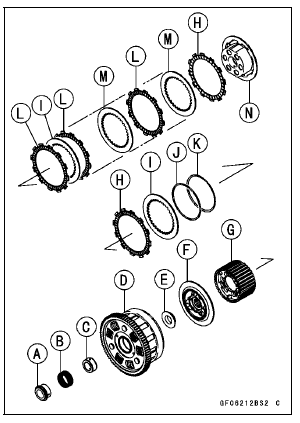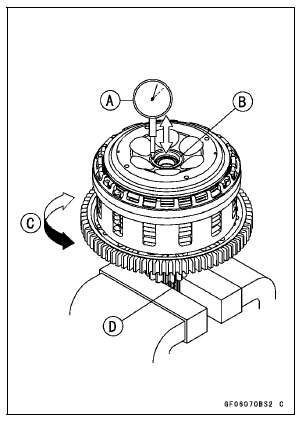

Insufficient clutch free play will cause the engine braking effect to be more sudden, resulting in rear wheel hop. On the other hand, if the free play is excessive, the clutch lever may feel “spongy” or pulsate when pulled.
Collar [A]
Needle Bearing [B]
Sleeve [C]
Clutch Housing [D]
Spacer [E]
Clutch Hub [F]
Sub Clutch Hub [G]
Friction Plates (48 Lining Blocks) [H] (#1, #10)
Steel Plates (T = 2.9) [I] (#1 
#7)
Spring Seat [J]
Spring [K]
Friction Plates (36 Lining Blocks) [L] (#2
 #9)
#9)
Steel Plates (T = 2.6) [M] (#8, #9)
Clutch Spring Plate [N]

Drive Shaft [D]
Spring Plate Free Play
Usable Range: 0.05  0.70 mm (0.002
0.70 mm (0.002
 0.028 in.)
0.028 in.)

If the free play is not within the usable range, change all of the friction plate and measure the free play again.
If the free play is not within the usable range, adjust the free play (see Spring Plate Free Play Adjustment).
 Clutch Installation
Clutch Installation Spring Plate Free Play Adjustment
Spring Plate Free Play AdjustmentHeadlight Bulb Replacement
Turn the cover [A] counterclockwise, and remove it.
Disconnect the headlight connector [A].
Open the clamp [B], and remove the bulb.
NOTICE
When handling the quartz-halogen bulb, never
touch the glass portion with bare hands. Always
use a clean cloth. Oil contamination from hand ...
Thermostat Removal
Remove:
Fuel Tank (see Fuel Tank Removal in the Fuel System
(DFI) chapter)
Air Cleaner Housing (see Air Cleaner Housing Removal
in the Fuel System (DFI) chapter)
Throttle Body Assy (see Throttle Body Assy Removal in
the Fuel System (DFI) chapter)
Throttle Body Assy Holder Clamp [A]
...
Sidestand Removal
Raise the rear wheel off the ground with the stand [A].
Remove:
Sidestand Switch Bolt [A]
Sidestand Switch [B]
Remove:
Spring [A]
Sidestand Nut [B]
Sidestand Bolt [C]
Sidestand [D]
...